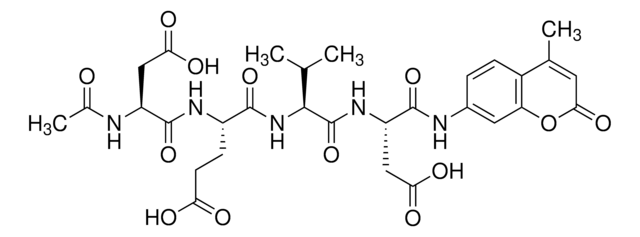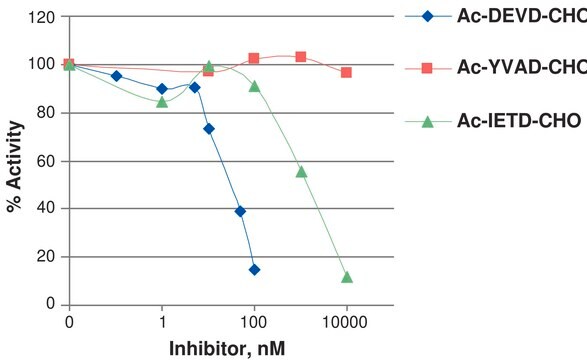推薦產品
重組細胞
expressed in E. coli (C-terminal histidine-tagged)
品質等級
化驗
≥90% (SDS-PAGE)
形狀
buffered aqueous solution
比活性
>2,000 units/mg protein
分子量
N-terminal prodomain plus the large subunit. 36 kDa (caspase 9 expressed as a C-terminal histidine-tagged protein appears as a two-subunit protein)
small subunit 13 kDa (subunit containing the histidine tag)
UniProt登錄號
運輸包裝
dry ice
儲存溫度
−70°C
基因資訊
human ... CASP9(842)
尋找類似的產品? 前往 產品比較指南
生化/生理作用
When cells receive apoptotic stimuli, such as activation of the TNFα/Fas cell surface receptor, caspase 8 activation, Bid processing and its translocation to the mitochondria ensue. As a result mitochondria release cytochrome c which then binds to Apaf-1, the mammalian Ced-4 homologue, together with dATP. The resultant complex recruits caspase 9 leading to its activation. It then cleaves downstream caspases such as caspase 3, 6, and 7, initiating the caspase cascade. Caspase 9 exhibits basal activity. It can be further activated via interaction of its N-terminal prodomain with the activator protein Apaf-1 in the presence of cytochrome c and dATP. Caspases have been implicated in many disorders including cancer, inflammatory disease, neurodegenerative diseases, stroke and myocardial infarction.
單位定義
One unit will cleave 1.0 nmol of Ac-Leu-Glu-His-Asp-AFC per hr at 25 °C at pH 6.5.
外觀
Solution in 10% sucrose containing 50 mM HEPES, pH 7.5, 5 mM DTT, 0.1% CHAPS, 1 mM EDTA, 50 mM NaCl.
儲存類別代碼
12 - Non Combustible Liquids
水污染物質分類(WGK)
WGK 1
閃點(°F)
Not applicable
閃點(°C)
Not applicable
個人防護裝備
Eyeshields, Gloves, multi-purpose combination respirator cartridge (US)
分析證明 (COA)
輸入產品批次/批號來搜索 分析證明 (COA)。在產品’s標籤上找到批次和批號,寫有 ‘Lot’或‘Batch’.。
H Duan et al.
The Journal of biological chemistry, 271(28), 16720-16724 (1996-07-12)
Members of the ICE/Ced-3 gene family are likely effector components of the cell death machinery. Here, we characterize a novel member of this family designated ICE-LAP6. By phylogenetic analysis, ICE-LAP6 is classified into the Ced-3 subfamily which includes Ced-3, Yama/CPP32/apopain
S M Srinivasula et al.
The Journal of biological chemistry, 271(43), 27099-27106 (1996-10-25)
Recent evidence suggests that CPP32 is an essential component of an aspartate-specific cysteine protease (ASCP) cascade responsible for apoptosis execution in mammalian cells. Activation of CPP32 could lead to activation of other downstream ASCPs, resulting in late morphological changes such
H R Stennicke et al.
The Journal of biological chemistry, 274(13), 8359-8362 (1999-03-20)
The recombinant form of the proapoptotic caspase-9 purified following expression in Escherichia coli is processed at Asp315, but largely inactive; however, when added to cytosolic extracts of human 293 cells it is activated 2000-fold in the presence of cytochrome c
K Kuida
The international journal of biochemistry & cell biology, 32(2), 121-124 (2000-02-25)
Caspase-9 is a member of caspase family of cysteine proteases that have been implicated in apoptosis and cytokine processing. When cells receive apoptotic stimuli, mitochondria releases cytochrome c which then binds to Apaf-1, the mammalian Ced-4 homologue, together with dATP.
BCL-2 family members and the mitochondria in apoptosis.
A Gross et al.
Genes & development, 13(15), 1899-1911 (1999-08-13)
我們的科學家團隊在所有研究領域都有豐富的經驗,包括生命科學、材料科學、化學合成、色譜、分析等.
聯絡技術服務





